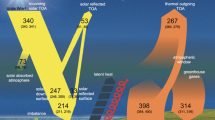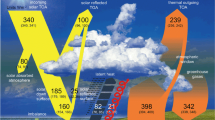Abstract
While global observational estimates of energy fluxes in and out of the climate system at the top of atmosphere (TOA) are now available with considerable accuracy from recent satellite programs, similar reference values are more difficult to establish for the surface energy fluxes, which cannot be directly measured from space. This is reflected in greatly diverging global estimates of the surface energy balance components that have been published over the years, or simulated in global climate models. Since the mid-1990s, accurate direct measurements become increasingly available from the networks of surface radiation stations, which allow to better constrain the energy fluxes at the Earth’s surface. In parallel, satellite-derived products of surface fluxes profit from the great advancement in space-born observation systems that became operational since the turn of the millennium. As a consequence, recent independent global estimates of the surface radiation components based on surface and satellite data sources have converged to within a few watts per square meter. This suggests that we are approaching a stage where we are not only confident in the magnitudes of the global energy balance components at the TOA but also increasingly so at the surface. These recent estimates may also be able to reconcile formerly disputed inconsistencies between global energy and water cycle estimates. Remaining challenges include the accurate determination of representative surface albedos and skin temperatures in the calculation of surface shortwave absorption and upward longwave emission, respectively, as well as the partitioning of surface net radiation into the nonradiative fluxes of sensible and latent heat.




Similar content being viewed by others
References
Ohmura A. The development and the present status of energy balance climatology. J Meteorol Soc Jpn. 2014;92(4):245–85. doi:10.2151/jmsj.2014-401.
Barkstrom BR, Harrison EF, Lee III RB. Earth radiation budget experiment. Eos. 1990;71:297–305.
Ohmura A, Gilgen H. Reevaluation of the global energy balance. In: McBean GA, Hantel M, editors. Interactions between global climate subsystems—the legacy of Hann, Geophysical Monograph Series, vol. 75. Washington: Amer Geophysical Union; 1993. p. 93–110.
Kiehl JT, Trenberth KE. Earth’s annual global mean energy budget. Bull Am Meteorol Soc. 1997;78(2):197–208.
Wild M, Ohmura A, Gilgen H, Roeckner E, Giorgetta M, Morcrette JJ. The disposition of radiative energy in the global climate system: GCM-calculated versus observational estimates. Clim Dyn. 1998;14(12):853–69.
Rossow WB, Zhang YC. Calculation of surface and top of atmosphere radiative fluxes from physical quantities based on ISCCP data sets: 2. Validation and first results. J Geophys Res. 1995;100(D1):1167–97.
Wild M, Folini D, Schar C, Loeb N, Dutton EG, König-Langlo G. The global energy balance from a surface perspective. Clim Dyn. 2013;40(11–12):3107–34. doi:10.1007/S00382-012-1569-8.
Wild M, Folini D, Hakuba MZ, Schar C, Seneviratne SI, Kato S, Rutan D, Ammann C, Wood EF, Konig-Langlo G. The energy balance over land and oceans: an assessment based on direct observations and CMIP5 climate models. Clim Dyn. 2015;44(11–12):3393–429. doi:10.1007/s00382-014-2430-z.
Loeb NG, Kato S, Su WY, Wong TM, Rose FG, Doelling DR, Norris JR, Huang XL. Advances in understanding top-of-atmosphere radiation variability from satellite observations. Surv Geophys. 2012;33(3–4):359–85. doi:10.1007/S10712-012-9175-1.
Anderson DE, Cahalan RF. The solar radiation and climate experiment (SORCE) mission for the NASA earth observing system (EOS). Sol Phys. 2005;230(1–2):3–6. doi:10.1007/S11207-005-1592-6.
Trenberth KE, Fasullo JT, Kiehl J. Earth’s global energy budget. Bull Am Meteorol Soc. 2009;90(3):311. doi:10.1175/2008bams2634.1.
Stephens GL, Li JL, Wild M, Clayson CA, Loeb N, Kato S, L’Ecuyer T, Stackhouse PW, Lebsock M, Andrews T. An update on Earth’s energy balance in light of the latest global observations. Nat Geosci. 2012;5(10):691–6. doi:10.1038/Ngeo1580.
Trenberth KE, Fasullo JT. Tracking Earth’s energy: from El Niño to global warming. Surv Geophys. 2012;33(3–4):413–26. doi:10.1007/S10712-011-9150-2.
Wild M. New directions: a facelift for the picture of the global energy balance. Atmos Environ. 2012;55:366–7. doi:10.1016/J.Atmosenv.2012.03.022.
Gilgen H, Wild M, Ohmura A. Means and trends of shortwave irradiance at the surface estimated from global energy balance archive data. J Clim. 1998;11(8):2042–61.
Dutton EG, Nelson DW, Stone RS, Longenecker D, Carbaugh G, Harris JM, Wendell J. Decadal variations in surface solar irradiance as observed in a globally remote network. J Geophys Res-Atmos. 2006;111(D19):D19101. doi:10.1029/2005jd006901.
Shi GY, Hayasaka T, Ohmura A, Chen ZH, Wang B, Zhao JQ, Che HZ, Xu L. Data quality assessment and the long-term trend of ground solar radiation in China. J Appl Meteorol Clim. 2008;47(4):1006–16. doi:10.1175/2007jamc1493.1.
Wang KC, Dickinson RE, Ma Q, Augustine JA, Wild M. Measurement methods affect the observed global dimming and brightening. J Clim. 2013;26(12):4112–20. doi:10.1175/Jcli-D-12-00482.1.
Ohmura A, Dutton EG, Forgan B, Frohlich C, Gilgen H, Hegner H, Heimo A, König-Langlo G, McArthur B, Muller G, Philipona R, Pinker R, Whitlock CH, Dehne K, Wild M. Baseline Surface Radiation Network (BSRN/WCRP): new precision radiometry for climate research. Bull Am Meteorol Soc. 1998;79(10):2115–36.
König-Langlo G, Sieger R, Schmithüsen H, Bücker A, Richter F, Dutton EG. Baseline Surface Radiation Network (BSRN)—update of the technical plan for BSRN data management, vol. GCOS-174 (WCRP24/2013). Geneva: World Meteorological Organization; 2013.
Ackerman TP, Stokes GM. The atmospheric radiation measurement program. Phys Today. 2003;56(1):38–44.
Augustine JA, DeLuisi JJ, Long CN. SURFRAD—a national surface radiation budget network for atmospheric research. Bull Am Meteorol Soc. 2000;81(10):2341–57.
Colbo K, Weller RA. Accuracy of the IMET sensor package in the subtropics. J Atmos Ocean Tech. 2009;26(9):1867–90. doi:10.1175/2009jtecho667.1.
Pinker RT, Frouin R, Li Z. A review of satellite methods to derive surface shortwave irradiance. Remote Sens Environ. 1995;51(1):108–24.
Raschke E, Kinne S, Rossow WB, Stackhouse PW, Wild M. Comparison of radiative energy flows in observational datasets and climate modeling. J Appl Meteorol Clim. 2016;55(1):93–117. doi:10.1175/Jamc-D-14-0281.1.
Kato S, Loeb NG, Rose FG, Doelling DR, Rutan DA, Caldwell TE, Yu LS, Weller RA. Surface irradiances consistent with CERES-derived top-of-atmosphere shortwave and longwave irradiances. J Clim. 2013;26(9):2719–40. doi:10.1175/Jcli-D-12-00436.1.
Stackhouse PW, Gupta SK, Cox SJ, Mikovitz JC, Zhang T, Hinkelman LM. The NASA/GEWEX surface radiation budget release 3.0: 24.5-year dataset. GEWEX News. 2011;21(1):10–2.
Hatzianastassiou N, Matsoukas C, Fotiadi A, Pavlakis KG, Drakakis E, Hatzidimitriou D, Vardavas I. Global distribution of Earth’s surface shortwave radiation budget. Atmos Chem Phys. 2005;5:2847–67.
Evan AT, Heidinger AK, Vimont DJ. Arguments against a physical long-term trend in global ISCCP cloud amounts. Geophys Res Lett. 2007;34(4):L04701. doi:10.1029/2006gl028083.
L’Ecuyer TS, Beaudoing HK, Rodell M, Olson W, Lin B, Kato S, Clayson CA, Wood E, Sheffield J, Adler R, Huffman G, Bosilovich M, Gu G, Robertson F, Houser PR, Chambers D, Famiglietti JS, Fetzer E, Liu WT, Gao X, Schlosser CA, Clark E, Lettenmaier DP, Hilburn K. The observed state of the energy budget in the early twenty-first century. J Clim. 2015;28(21):8319–46. doi:10.1175/Jcli-D-14-00556.1.
Berrisford P, Kallberg P, Kobayashi S, Dee D, Uppala S, Simmons AJ, Poli P, Sato H. Atmospheric conservation properties in ERA-Interim. Quarterly J R Meteorol Soc. 2011;137(659):1381–99. doi:10.1002/Qj.864.
Bosilovich MG, Robertson FR, Chen JY. Global energy and water budgets in MERRA. J Clim. 2011;24(22):5721–39. doi:10.1175/2011jcli4175.1.
Wild M, Ohmura A, Gilgen H, Roeckner E. Validation of general-circulation model radiative fluxes using surface observations. J Clim. 1995;8(5):1309–24.
Wild M. Solar radiation budgets in atmospheric model intercomparisons from a surface perspective. Geophys Res Lett. 2005;32(7):L07704. doi:10.1029/2005gl022421.
Wild M. Short-wave and long-wave surface radiation budgets in GCMs: a review based on the IPCC-AR4/CMIP3 models. Tellus A. 2008;60(5):932–45. doi:10.1111/J.1600-0870.2008.00342.X.
Wild M Surface and atmospheric radiation budgets as determined in reanalyses. In: Smith WL, Timofeyev YM (eds) Irs 2000: Current Problems in Atmospheric Radiation, 2001. A. Deepak Publishing, pp 602–605.
Ma Q, Wang KC, Wild M. Impact of geolocations of validation data on the evaluation of surface incident shortwave radiation from Earth System Models. J Geophys Res-Atmos. 2015;120(14):6825–44. doi:10.1002/2014jd022572.
Kim DY, Ramanathan V. Solar radiation budget and radiative forcing due to aerosols and clouds. J Geophys Res-Atmos. 2008;113(D2):D02203. doi:10.1029/2007jd008434.
Zhang YC, Rossow WB, Lacis AA, Oinas V, Mishchenko MI. Calculation of radiative fluxes from the surface to top of atmosphere based on ISCCP and other global data sets: refinements of the radiative transfer model and the input data. J Geophys Res-Atmos. 2004;109(D19):D19105. doi:10.1029/2003jd004457.
Loeb NG, Wielicki BA, Doelling DR, Smith GL, Keyes DF, Kato S, Manalo-Smith N, Wong T. Toward optimal closure of the Earth’s top-of-atmosphere radiation budget. J Clim. 2009;22(3):748–66. doi:10.1175/2008jcli2637.1.
Wild M, Ohmura A, Gilgen H, Morcrette JJ, Slingo A. Evaluation of downward longwave radiation in general circulation models. J Clim. 2001;14(15):3227–39.
Ma Q, Wang K, Wild M. Evaluations of atmospheric downward longwave radiation from 44 coupled general circulation models of CMIP5. J Geophys Res Atmos. 2014;119:4486–97. doi:10.1002/2013JD021427.
Mlawer EJ, Taubman SJ, Brown PD, Iacono MJ, Clough SA. Radiative transfer for inhomogeneous atmospheres: RRTM, a validated correlated-k model for the longwave. J Geophys Res-Atmos. 1997;102(D14):16663–82.
Wild M, Roeckner E. Radiative fluxes in the ECHAM5 general circulation model. J Clim. 2006;19(16):3792–809.
Allan RP, Ringer MA, Pamment JA, Slingo A. Simulation of the Earth’s radiation budget by the European Centre for Medium-Range Weather Forecasts 40-year reanalysis (ERA40). J Geophys Res-Atmos. 2004;109(D18):D18107. doi:10.1029/2004jd004816.
IPCC (2001) Climate Change 2001: the scientific basis. Contribution of Working Group I to the Third Assessment Report of the Intergovernmental Panel on Climate Change. Cambridge, United Kingdom.
IPCC (2007) Climate Change 2007: the physical science basis. Contribution of Working Group 1 to the Fourth Assessment Report of the Intergovernmental Panel on Climate Change. Cambridge, United Kingdom and New York, NY, USA.
Simmons AJ, Jones PD, Bechtold VD, Beljaars ACM, Kallberg PW, Saarinen S, Uppala SM, Viterbo P, Wedi N. Comparison of trends and low-frequency variability in CRU, ERA-40, and NCEP/NCAR analyses of surface air temperature. J Geophys Res-Atmos. 2004;109(D24):D24115. doi:10.1029/2004jd005306.
Jin ML, Dickinson RE. Land surface skin temperature climatology: benefitting from the strengths of satellite observations. Environ Res Lett. 2010;5(4):044004. doi:10.1088/1748-9326/5/4/044004.
von Schuckmann K, Palmer MD, Trenberth KE, Cazenave A, Chambers D, Champollion N, Hansen J, Josey SA, Loeb N, Mathieu PP, Meyssignac B, Wild M. An imperative to monitor Earth’s energy imbalance. Nat Clim Chang. 2016;6(2):138–44. doi:10.1038/Nclimate2876.
Ohmura A, Raschke E. Energy budget at the Earth’s surface. In: Hantel M, editor. Observed global climate. Landolt-Börnstein: numerical data and functional relationships in science and technology—new series, vol. 6. Heidelberg, New York: Springer Berlin; 2005.
Hatzianastassiou N, Matsoukas C, Hatzidimitriou D, Pavlakis C, Drakakis M, Vardavas I. Ten year radiation budget of the earth: 1984–93. Int J Climatol. 2004;24(14):1785–802. doi:10.1002/joc.1110.
Gupta SK, Ritchey NA, Wilber AC, Whitlock CH, Gibson GG, Stackhouse PW. A climatology of surface radiation budget derived from satellite data. J Clim. 1999;12(8):2691–710.
Acknowledgements
I would like to thank Profs. Richard Allan and Brian Soden for soliciting and editing this manuscript, and two anonymous reviewers for much appreciated constructive comments. I am grateful to Prof. Atsumu Ohmura for many stimulating discussions on the global energy balance, and Prof. Christoph Schär for his continuous support. Dr. Doris Folini is highly acknowledged for her great support in the CMIP5 data analysis. The global energy balance diagram shown in this paper was designed by Barbara Schär. My research on the global energy balance is supported by the Swiss National Science Foundation grants 200021 135395 and 200020 159938.
Author information
Authors and Affiliations
Corresponding author
Additional information
This article is part of the Topical Collection on Global Energy Budgets
Rights and permissions
About this article
Cite this article
Wild, M. Towards Global Estimates of the Surface Energy Budget. Curr Clim Change Rep 3, 87–97 (2017). https://doi.org/10.1007/s40641-017-0058-x
Published:
Issue Date:
DOI: https://doi.org/10.1007/s40641-017-0058-x




